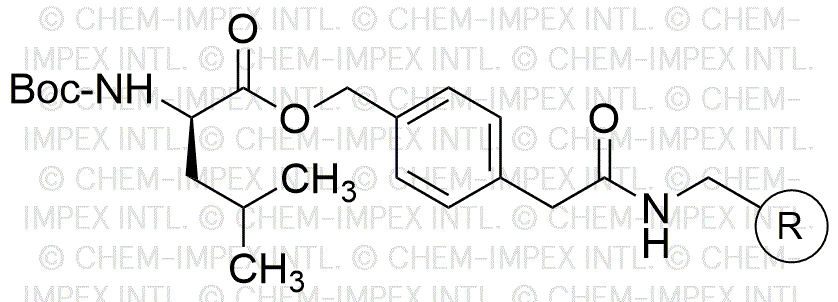Boc-D-leucine 4-oxymethylphenylacetamidomethyl is widely utilized in research focused on:
- Peptide Synthesis: This compound serves as a key building block in the synthesis of peptides, particularly those requiring D-amino acids, enhancing the stability and bioactivity of the resulting peptides.
- Drug Development: In pharmaceutical research, it is used to create novel drug candidates, especially in the development of therapeutics targeting specific biological pathways, improving efficacy and reducing side effects.
- Bioconjugation: The compound is applied in bioconjugation processes, allowing researchers to attach biomolecules to drugs or imaging agents, which can enhance targeting and delivery in therapeutic applications.
- Research on Protein Folding: It aids in studies related to protein folding and stability, providing insights into the behavior of proteins in various environments, which is crucial for understanding diseases.
- Material Science: In material science, it is utilized to modify surfaces and create functional materials, contributing to advancements in drug delivery systems and biomaterials.
Informations générales
Propriétés
Sécurité et réglementation
Applications
Boc-D-leucine 4-oxymethylphenylacetamidomethyl is widely utilized in research focused on:
- Peptide Synthesis: This compound serves as a key building block in the synthesis of peptides, particularly those requiring D-amino acids, enhancing the stability and bioactivity of the resulting peptides.
- Drug Development: In pharmaceutical research, it is used to create novel drug candidates, especially in the development of therapeutics targeting specific biological pathways, improving efficacy and reducing side effects.
- Bioconjugation: The compound is applied in bioconjugation processes, allowing researchers to attach biomolecules to drugs or imaging agents, which can enhance targeting and delivery in therapeutic applications.
- Research on Protein Folding: It aids in studies related to protein folding and stability, providing insights into the behavior of proteins in various environments, which is crucial for understanding diseases.
- Material Science: In material science, it is utilized to modify surfaces and create functional materials, contributing to advancements in drug delivery systems and biomaterials.
Documents
Fiches de données de sécurité (FDS)
La FDS fournit des informations de sécurité complètes sur la manipulation, le stockage et l’élimination du produit.
Spécifications du produit (PS)
Le PS fournit une description complète des propriétés du produit, notamment sa composition chimique, son état physique, sa pureté et les exigences de stockage. Il détaille également les plages de qualité acceptables et les applications prévues du produit.
Certificats d'analyse (COA)
Recherchez des certificats d'analyse (COA) en saisissant le numéro de lot du produit. Les numéros de lot et de lot se trouvent sur l'étiquette d'un produit, après les mots « Lot » ou « Lot de fabrication ».
Numéro de catalogue
Numéro de lot/série
Certificats d'origine (COO)
Ce certificat d'exploitation confirme le pays dans lequel le produit a été fabriqué, et détaille également les matériaux et composants utilisés et s'il est issu de sources naturelles, synthétiques ou autres sources spécifiques. Ce certificat peut être requis pour les douanes, le commerce et la conformité réglementaire.
Numéro de catalogue
Numéro de lot/série
Fiches de données de sécurité (FDS)
La FDS fournit des informations de sécurité complètes sur la manipulation, le stockage et l’élimination du produit.
DownloadSpécifications du produit (PS)
Le PS fournit une description complète des propriétés du produit, notamment sa composition chimique, son état physique, sa pureté et les exigences de stockage. Il détaille également les plages de qualité acceptables et les applications prévues du produit.
DownloadCertificats d'analyse (COA)
Recherchez des certificats d'analyse (COA) en saisissant le numéro de lot du produit. Les numéros de lot et de lot se trouvent sur l'étiquette d'un produit, après les mots « Lot » ou « Lot de fabrication ».
Numéro de catalogue
Numéro de lot/série
Certificats d'origine (COO)
Ce certificat d'exploitation confirme le pays dans lequel le produit a été fabriqué, et détaille également les matériaux et composants utilisés et s'il est issu de sources naturelles, synthétiques ou autres sources spécifiques. Ce certificat peut être requis pour les douanes, le commerce et la conformité réglementaire.

